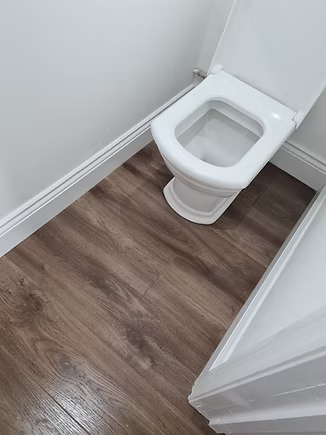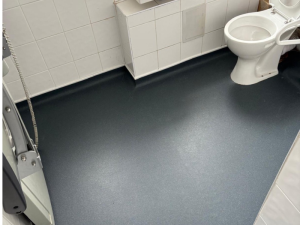Bathrooms are the toughest room in the house when it comes to flooring. You’ve got constant moisture in the air, splashes from the shower or bath, and the odd plumbing leak that can cause havoc if your floor isn’t built for it. Over the years, I’ve seen plenty of floors go down that simply weren’t suited for the job, and it usually ends in disappointment (and a replacement bill).
At Floors2u, we guide customers through this decision every day. The three types we get asked about most are vinyl, laminate, and real wood. Each has its place in a home, but not all of them are equally happy in a bathroom. Here’s what you need to know.
Vinyl Flooring in Bathrooms
If there’s one product I’ll always feel confident recommending for a bathroom, it’s vinyl. And I’m not talking about the thin sheet vinyl that used to be common in the ’80s. Modern vinyl—especially luxury vinyl tile (LVT) or vinyl plank—is a completely different story. It’s thicker, harder-wearing, and designed to look convincingly like wood, stone, or tile.
Pros:
- Waterproof performance: Vinyl shrugs off splashes, spills, and steam. Install it correctly with proper sealing around the edges, and you’re set.
- Comfortable underfoot: Warmer and softer than ceramic or stone—ideal when you step out of the shower barefoot.
- Easy to maintain: A quick mop is usually all it needs.
- Design choice: Whether you want natural oak, sleek marble, or patterned tile effects, vinyl has you covered.
Cons:
- Surface marks: It can dent if something sharp is dropped on it.
- Life span: It won’t last as long as ceramic tile or natural stone—but with quality vinyl, you’ll still get many solid years of use.
For most households, vinyl is the most practical, worry-free option, which is why it’s a best-seller at Floors2u.
Laminate Flooring in Bathrooms
Laminate is hugely popular in living areas and bedrooms because it’s affordable and looks the part. But bathrooms are another story. Laminate is made with a high-density fibreboard (HDF) core, and no matter how well you seal it, that core doesn’t get along with water.
Pros:
- Affordable: Laminate usually comes in cheaper than vinyl or wood.
- Plenty of styles: Realistic wood and stone effects at a lower cost.
- Durability in dry spaces: In the right room, it holds up well.
Cons:
- Moisture issues: If water seeps into the joins, the boards will swell and warp. Once that happens, it can’t be repaired.
- High maintenance in wet rooms: You’d need to stay on top of every splash, which isn’t realistic for most bathrooms.
- Shorter lifespan in damp areas: Even “water-resistant” laminate has its limits.
In short: laminate’s a strong choice elsewhere, but in a bathroom, it’s a gamble.
Real Wood Flooring in Bathrooms
Real wood has an appeal nothing else can match. Oak, walnut, maple—every board has its own natural character, and it instantly elevates a room. That said, bathrooms are one of the most demanding environments for timber.
Pros:
- Unbeatable appearance: No replica looks or feels quite like genuine wood.
- Adds value: Real wood flooring is seen as a premium feature.
- Longevity with care: Properly maintained, wood can last for decades.
Cons:
- Moisture sensitivity: Wood naturally expands and contracts when exposed to humidity. Over time, that movement can cause gaps or distortion.
- Maintenance demands: Needs regular sealing and more careful upkeep than synthetic options.
- Cost: It’s generally the most expensive option, both in materials and upkeep.
Engineered wood (layered construction with a real wood top) is a slightly better performer in bathrooms than solid wood, but it still requires consistent care and caution.
The Verdict
When choosing flooring for a bathroom, you need something that can take daily splashes and humidity without constant worry. That’s why vinyl flooring is usually the smart choice: it’s waterproof, stylish, and low-maintenance. Laminate works brilliantly elsewhere in the home, but in bathrooms it’s not worth the risk. Real wood looks stunning, but it’s high-maintenance and better suited to living areas where moisture won’t be a constant battle.
At the end of the day, the best bathroom floor is one that suits your lifestyle and how much upkeep you’re prepared to handle. For most people, vinyl is the reliable, stress-free option.
You can explore a wide range of vinyl, laminate, and real wood flooring at Floors2u—and find the right match for your bathroom project.




